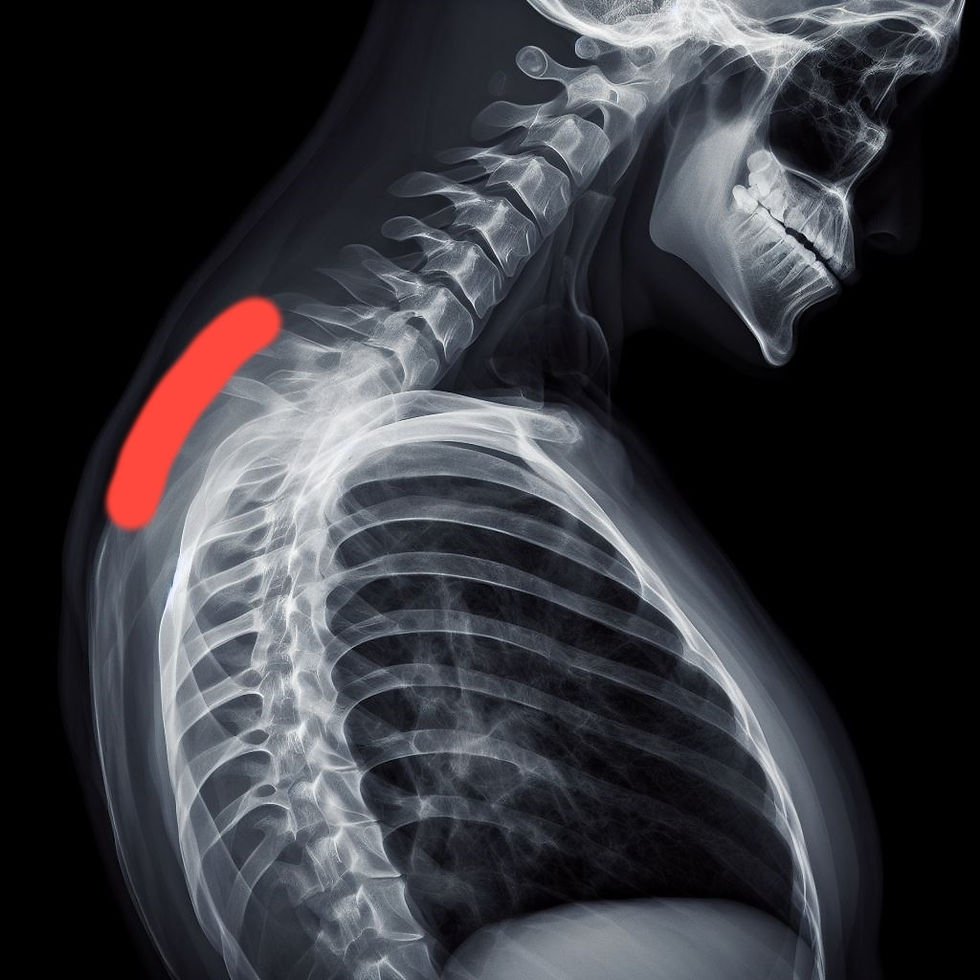Understanding Dowager's Hump: Causes, Prevention, and Treatment
- mmajaess
- Nov 7, 2023
- 3 min read
Introduction
Dowager's Hump, sometimes referred to as Dowager's deformity or simply a "hunchback," is a condition that can have a significant impact on one's quality of life. While it primarily affects older adults, it can develop in people of all ages due to poor posture, underlying medical conditions, or a combination of both. In this blog post, we will delve into the causes, prevention, and treatment of Dowager's Hump, shedding light on this often misunderstood condition.

What is Dowager's Hump?
Dowager's Hump is a colloquial term for an excessive curvature of the upper spine, leading to a noticeable hump or rounded appearance at the upper back and neck region. It is most commonly associated with osteoporosis, a condition that weakens the bones and makes them more susceptible to fractures.
Causes of Dowager's Hump
1. Osteoporosis: Osteoporosis is the leading cause of Dowager's Hump. In this condition, the bones become fragile and porous, resulting in vertebral compression fractures. These fractures, especially in the upper spine, can contribute to the characteristic hump formation.
2. Poor Posture: While osteoporosis is a major contributor, poor posture plays a crucial role in the development of Dowager's Hump. Prolonged slouching, hunching over electronic devices, and carrying heavy bags can all lead to spinal misalignment and muscle imbalances.

3. Age: As we age, our bones and muscles may naturally weaken, making us more susceptible to spinal deformities like Dowager's Hump. However, this condition is not exclusive to older adults and can develop in younger individuals due to posture-related issues.
Preventing Dowager's Hump
Prevention is often the best approach to managing Dowager's Hump. Here are some tips to help prevent its development:
1. Maintain Good Posture: Be conscious of your posture, especially when sitting and standing. Keep your spine aligned, shoulders back, and head upright.
2. Regular Exercise: Engaging in exercises that strengthen the muscles supporting your spine can help prevent Dowager's Hump. Focus on activities that improve posture, like yoga or Pilates.
3. Balanced Diet: Ensure your diet includes adequate calcium and vitamin D, which are essential for bone health. Consult a healthcare provider for personalized dietary recommendations.
4. Bone Density Testing: If you are at risk of osteoporosis, consider getting a bone density test. Early detection and treatment can help prevent spinal fractures.
Treatment Options
If you or someone you know is already dealing with Dowager's Hump, various treatment options are available to manage and improve the condition:
1. Chiropractic Care: Chiropractors can assess your spinal health, perform spinal adjustments, and recommend exercises to improve posture and alleviate pain associated with Dowager's Hump.
2. Physical Therapy: Physical therapists can design customized exercise programs to strengthen the muscles supporting the spine and improve posture.
3. Medications: In cases related to osteoporosis, your healthcare provider may prescribe medications to slow bone loss and reduce the risk of fractures.
4. Lifestyle Modifications: Lifestyle changes, including ergonomic adjustments, can help alleviate discomfort and slow the progression of Dowager's Hump.
Conclusion
Dowager's Hump is a condition that can significantly impact one's physical appearance and overall well-being. Understanding its causes, prevention methods, and treatment options is essential for maintaining a healthy spine and a good quality of life. By making conscious efforts to maintain good posture, engage in regular physical activity, and seek appropriate medical guidance, you can reduce the risk of developing Dowager's Hump and improve your spinal health. Remember, it's never too late to take steps towards a healthier, hump-free future.




Comments